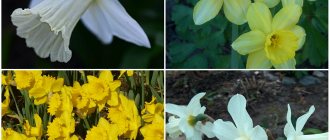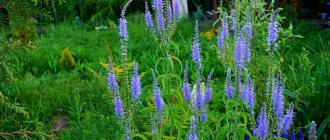Beginner gardeners often face disappointment when the most beautiful flowers in a flowerbed for some reason look inconspicuous, and the entire flowerbed looks sloppy and does not produce the expected effect. This happens when flowers are planted in a flowerbed at will, without adhering to certain rules for combinations of color, shape and style. In fact, decorating a flowerbed at the dacha with your own hands is quite possible if you know what flowers go together in the flowerbed.
Having experienced failure, gardeners fearfully begin to think about creating another flower bed or flower garden. You can master this difficult science of successfully combining plants if you first master the basic rules and then move on to studying specific issues.
To make the flower bed look attractive, it is important to choose flowers that match each other in color and height.
Main types and varieties of daffodils
The most favorite and common types of this flower are the following:
- tubular - the length of the middle, the so-called tube, and the petals of the inflorescence are the same, sometimes the tube is longer than the petals;
- large-crowned - a characteristic feature is that the length of the crown of the inflorescence is approximately half the length of the petal;
- small-crowned - the length of the crown is only a few millimeters;
- split-crowned - the middle of the flower comes in different sizes and lengths, the main feature is that the crown looks torn or fringed. Very spectacular and beautiful inflorescences;
- terry varieties. Also beautiful and unusual plants with large flowers. Some double varieties have very large inflorescences and the stem does not support such a large and heavy flower, so a special support is placed for them;
- cyclamenoid - the shape of the inflorescence resembles cyclamen. The middle of this variety is long and thin. Early variety of daffodils;
- Jonquils are a late variety that has several small inflorescences on the stem.
Tulips
Today there are a large number of types and colors of tulips; they fit perfectly into almost any composition. From these flowers you can create flower beds with geometric patterns, ornaments and patterns of plain or contrasting colors.
A flowerbed of just tulips, composed of different varieties, will look great. You can plant several varieties of bulbous plants in one space; they will complement each other perfectly.
Probably everyone who has seen daffodils and tulips standing next to each other will agree that this is a beautiful combination of spring flowers. A successful combination would be to plant decorative onions and gypsophila among the tulips. They can be used to dilute other flower beds with a later flowering period. Chrysanthemums, gladioli, phlox and marigolds will be excellent neighbors.
You should not plant lilies and tulips together - they are prone to the same diseases and pests.
How to provide favorable conditions for flowering
In order for daffodils in the garden to bloom magnificently and amicably, they should be fed several times. During the season, it is recommended to do several feedings:
- The first fertilizing should be done after the first shoots appear. You should take any mineral fertilizer (30 g per 1 square meter), dilute it in water and fertilize the green sprouts;
- the second fertilizer is recommended to be applied during the budding of the bush (20 g per 1 square meter); the third feeding should be carried out after flowering. For this you will need phosphorus and potassium fertilizers.
The rest of plant care consists of removing weeds, slightly loosening the soil and regularly watering the flowers. It is recommended to water them from below, without touching the leaves and especially the flower.
Using a duet with other colors
Tulips can peacefully coexist in the same flower bed with other plants; moreover, even the most unexpected duets at first glance give excellent results and create stylish and original compositions. The main criterion for selecting potential neighbors of this bulbous plant is the similarity in requirements for lighting, moisture, as well as the composition and structure of the soil.
Did you know? Cut tulips do not stop growing. When placed in a vase with water, they can grow approximately another 3 cm.
Most often, tulips are planted in the same area with other bulbous plants. This makes it possible to dig up the bulbs after flowering, and grow annuals in the vacated area. Tulips and daffodils look romantic and at the same time elegant in the same flower bed. The combination with crocuses and hyacinths looks very gentle and festive in a spring-like way.
It is also recommended to place tulips in flower beds with annual flowers with bright and abundant flowering (zinnias, petunias, asters, pansies). It is important that the roots of annuals are loose and shallow - this way they will not interfere with the development of the bulbs. Perennial neighbors for tulips can be hostas, peonies, gypsophila, and ferns. You can also plant tulips in the foreground, with ornamental shrubs such as weigela and rhododendron in the background.
Tulips are amazing spring flowers. Despite their short flowering period, many admire their beauty and diversity. With the right approach, you can create a real masterpiece of landscape design on your site.
Narcissus in the house
Many people know about planting daffodils in open ground, but not everyone is aware that a delicate flower can be easily grown on a windowsill in your apartment.
To do this, in the fall you should prepare small containers with nutritious soil for flowering plants. Make a hole, plant the selected bulb, water it and move the pot to a cool place. Once every 2 weeks, the soil in the pot should be slightly moistened.
At the end of March, the onion already begins to sprout. From now on, it is recommended to move it to a warm and sunny place. After the bud appears, the temperature in the room should be reduced again.
The home flower daffodil does not like drafts. During the period of budding and flowering, it should be fed with a mineral mixture of fertilizers.
Daffodils always look graceful and attractive. Any plant variety is a small masterpiece of nature. With their flowering and beauty, they welcome spring and the approach of warm days.
Landing site design
In addition to the above, designers also offer several original solutions for planting tulips and daffodils:
- planting under trees (preferably fruit trees). You can create a hedge from almost any variety of tulips. It is preferable that the varieties are harmoniously combined in color and growth. According to experts, the best option would be Kaufman hybrids;
- A container garden is a chic option for decorating a terrace or a place to relax in the yard. In autumn, plant as many bulbs as possible in large or medium pots, and in spring they should be arranged in the desired area or placed in beautiful flowerpots;
- in the wheel of a car or cart;
- alpine slide. To create a rocky garden, low-growing species are better suited. It is better that the rock garden is located in a place that will receive the first spring sun rays. Designers recommend placing it near evergreen bushes;
- Daffodils look incredibly impressive in garden modules. These modules should be considered at the stage of flooring.
Possible diseases
Unfortunately, daffodils are susceptible to two quite serious infectious diseases - sclerotial rot and fusarium. They quickly destroy the plant, so it is advisable to immediately remove infected specimens from the garden bed and burn them.
It is almost impossible to cope with the disease, but you can significantly reduce the risk of the disease. Tops and leaves need to be removed and burned or sent to a compost heap, where the infection will die. Before planting, dip the bulbs in a disinfecting solution. A solution of potassium permanganate or methylene blue will do.
Low-growing annual flowers bloom all summer. Annuals or perennials - selection criteria
Many gardeners consider annual low flowers for flower beds to be the best option for decorating their plots, which:
- Quickly (during the planting season) they allow you to improve the territory by creating a beautiful composition.
- They have an incredible number of varieties, which makes it possible to select specimens for any zone on the site: sunny and shady, arid and waterlogged, with fertile and poor soil.
- They do not require special care, fertilizing or frequent watering in summer.
- They give creative people room for exciting experiments with the annual update of garden design.
- It is possible to correct mistakes in the selection of varieties and colors as early as the next season.
- Suitable for growing by novice gardeners, as they are mostly unpretentious.
Bright flowerbed of annuals
Fans of perennials refer to the unjustified loss of time, money, and effort when annually selecting plants for a flower bed, hassle with seedlings or sowing seeds in the ground. Of course, perennial low-growing flowers for the flower bed, blooming all summer, make it possible to avoid these worries for several years. But gradually they lose their decorative value, and once every 5-7 years they have to be renewed, spending more effort than planting annuals.
Perennials allow you to create flower beds that have a special charm, but they do not provide the same brightness and variety as annuals. The argument that weeds cannot grow under mats of perennial plantings is also controversial. Yes, under dense clumps the germination of weed seeds and the development of emerging weeds is suppressed. But if they have managed to make their way to the sun, it is much more difficult to destroy them than in annual plantings.
Perennial aubrieta
It is your choice to give preference to annual or perennial flowers, or perhaps a combination of both. In any case, it would be useful to take a closer look at some of their species.
Seed storage rules
Their germination and, accordingly, the density of the flower bed in the spring depend on the correct storage of the bulbs. What rules must be followed?
The dug up seeds are washed and dried (it is advisable to use a box with a mesh bottom for this) in a well-ventilated area, protected from direct sunlight. The optimal temperature is 20–25 degrees.
The bulbs are then placed in paper or fabric bags and stored at a temperature of 15–17 degrees Celsius.
Well, at the end of August or beginning of September you can plant them again to enjoy the most beautiful flowers in the spring.
Irises
Irises grow well in shaded areas, they are quite tall, and their inflorescences bloom at the beginning of the summer season.
As a neighbor, the iris is an excellent option; it gets along well with almost all plants. All that remains is to decide which composition to dilute with these bright, perky colors.
The iris will look good next to lilies, poppies or bergenia, as they grow at approximately the same height. If it is used to create a mixborder, then it is better to make it a background figure (or a central one for a circular flower bed). And then it’s a matter of your imagination. Petunias, tulips, clematis, phlox, lupins, heather, lavender or nasturtiums can be planted in the foreground.
In a monochrome flowerbed consisting only of irises, the space between them can be filled with decorative cereals.
The only plantings where the iris will be uncomfortable are bushes of roses and peonies; you should not plant them nearby.











